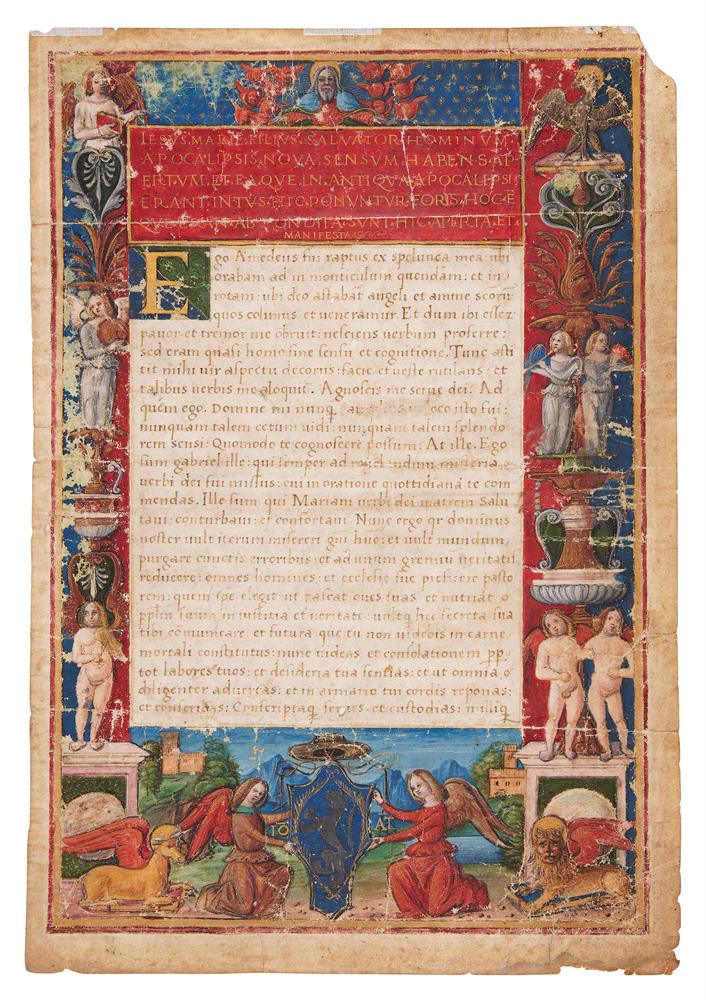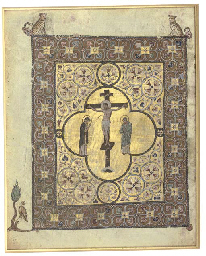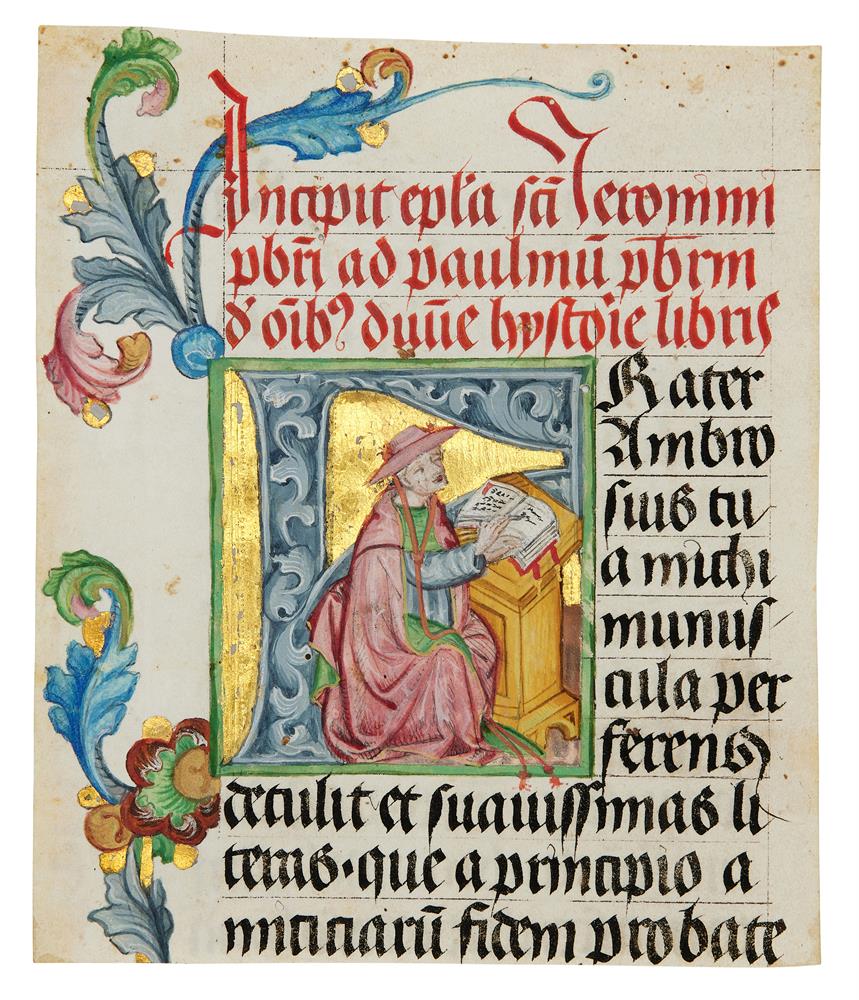The frontispiece leaf from an extremely early copy of the Apocalypsis Nova, attributed to the mystic Amadeus of Portugal, in Latin, fine Renaissance manuscript on parchment [northern Italy (the Veneto), opening decade or so of sixteenth century] Single leaf, with opening words of text in 6 lines of ornamental capitals in liquid gold on a purple panel, this above a 4-line initial 'E' (opening 'Ego Amedeus fui raptus et spelunca ...') in gold, on blue and dark green grounds, with full border of Renaissance architectural features on blue and burgundy grounds, enclosing numerous putti, angels playing musical instruments, God the Father appearing at the head of the page, and the bas-de-page with the symbols of the evangelists Luke (ox) and Mark (lion) before column bases, either side of angels who support a coat-of-arms (azure, a lion rampant argent flanked by two palm fronds or: perhaps that of the Dirossi family, all beneath a cardinal's or bishop's galero in black with only two tassels, i.e. in form used for priests), with the initials 'IO' and 'AT' at its sides (most probably abbreviations for the Latin forms of the original owner's first two names), this before a grassy and mountainous landscape, text in single column of 25 lines of an excellent humanist script on recto, and 30 lines of same on verso, some modern dealer's pencil marks on reverse, some scuffing and paint chipping due to folds, and losses to outer corners of leaf, some red (such as galero) oxidised to silver, overall in fair condition, 316 by 227mm. Provenance: 1. Written and decorated for a priest whose family arms appear in the bas-de-page of the recto; the arms without the palm fronds are recorded for the Dirossi family of the Veneto, and the owner may well have been a member of that family. Despite his lowly ecclesiastical office he clearly had wealth and influence, and given the extremely early date of this copy (the text was purportedly only discovered in 1502) its original owner may have been an important Amadean (a follower of Amadeus' reformed branch of the Franciscans: see below). 2. Christie's, 4 June 2008, lot 22. 3. Nosbüsch & Stucke GMBH, Berlin, their auction 25 October 2014, lot 1, unsold and reappearing as Artcurial, Maison de Vente Aux Enchères, Paris, France, 26 April 2018, lot 6, acquired there by Roger Martin after the sale. Text: Amadeus of Portugal was an influential mystic in Italy in the fifteenth and first half of the sixteenth century. He was born João de Menezes da Silva in 1420 to a prominent Portuguese family, and changed his name when he became a monk and then a Franciscan friar in Milan. There he was the subject of reports of miracles and went on to found a reformed branch of the Franciscan Order which bore his name (the Amadeans or Amadists). He served as private confessor to Pope Sixtus IV, and his followers established 28 of their own houses in Italy. After his death in 1482, he was beatified, but not canonised, and in 1568 his reformed branch was swept away among others in a papal reunification of the Franciscan Order. This text is part of the genre of prophetic-mystic works relying heavily on the Book of Revelations that emerged in late fifteenth-century Italy, and purports to have been dictated as a revelation to its author by the Archangel Gabriel. In it, Gabriel describes the future coming of a pope named 'the Angelic Pastor' who was to work with the emperor to restore harmony to the Church and reunite the Eastern and Western Churches, ushering in a new age of Christendom. However, the text was reported not to have been discovered until 1502, when Cardinal Bernardino Carvajal and the theologian Giorgio Benigno Salviati opened it after its discovery in either a cave or Amadeus' tomb, and so it may be in fact the work of an immediate follower of Amadeus, produced to further the interests of his reformed branch of the Franciscans.
The frontispiece leaf from an extremely early copy of the Apocalypsis Nova, attributed to the mystic Amadeus of Portugal, in Latin, fine Renaissance manuscript on parchment [northern Italy (the Veneto), opening decade or so of sixteenth century] Single leaf, with opening words of text in 6 lines of ornamental capitals in liquid gold on a purple panel, this above a 4-line initial 'E' (opening 'Ego Amedeus fui raptus et spelunca ...') in gold, on blue and dark green grounds, with full border of Renaissance architectural features on blue and burgundy grounds, enclosing numerous putti, angels playing musical instruments, God the Father appearing at the head of the page, and the bas-de-page with the symbols of the evangelists Luke (ox) and Mark (lion) before column bases, either side of angels who support a coat-of-arms (azure, a lion rampant argent flanked by two palm fronds or: perhaps that of the Dirossi family, all beneath a cardinal's or bishop's galero in black with only two tassels, i.e. in form used for priests), with the initials 'IO' and 'AT' at its sides (most probably abbreviations for the Latin forms of the original owner's first two names), this before a grassy and mountainous landscape, text in single column of 25 lines of an excellent humanist script on recto, and 30 lines of same on verso, some modern dealer's pencil marks on reverse, some scuffing and paint chipping due to folds, and losses to outer corners of leaf, some red (such as galero) oxidised to silver, overall in fair condition, 316 by 227mm. Provenance: 1. Written and decorated for a priest whose family arms appear in the bas-de-page of the recto; the arms without the palm fronds are recorded for the Dirossi family of the Veneto, and the owner may well have been a member of that family. Despite his lowly ecclesiastical office he clearly had wealth and influence, and given the extremely early date of this copy (the text was purportedly only discovered in 1502) its original owner may have been an important Amadean (a follower of Amadeus' reformed branch of the Franciscans: see below). 2. Christie's, 4 June 2008, lot 22. 3. Nosbüsch & Stucke GMBH, Berlin, their auction 25 October 2014, lot 1, unsold and reappearing as Artcurial, Maison de Vente Aux Enchères, Paris, France, 26 April 2018, lot 6, acquired there by Roger Martin after the sale. Text: Amadeus of Portugal was an influential mystic in Italy in the fifteenth and first half of the sixteenth century. He was born João de Menezes da Silva in 1420 to a prominent Portuguese family, and changed his name when he became a monk and then a Franciscan friar in Milan. There he was the subject of reports of miracles and went on to found a reformed branch of the Franciscan Order which bore his name (the Amadeans or Amadists). He served as private confessor to Pope Sixtus IV, and his followers established 28 of their own houses in Italy. After his death in 1482, he was beatified, but not canonised, and in 1568 his reformed branch was swept away among others in a papal reunification of the Franciscan Order. This text is part of the genre of prophetic-mystic works relying heavily on the Book of Revelations that emerged in late fifteenth-century Italy, and purports to have been dictated as a revelation to its author by the Archangel Gabriel. In it, Gabriel describes the future coming of a pope named 'the Angelic Pastor' who was to work with the emperor to restore harmony to the Church and reunite the Eastern and Western Churches, ushering in a new age of Christendom. However, the text was reported not to have been discovered until 1502, when Cardinal Bernardino Carvajal and the theologian Giorgio Benigno Salviati opened it after its discovery in either a cave or Amadeus' tomb, and so it may be in fact the work of an immediate follower of Amadeus, produced to further the interests of his reformed branch of the Franciscans.














.jpg)
Try LotSearch and its premium features for 7 days - without any costs!
Be notified automatically about new items in upcoming auctions.
Create an alert